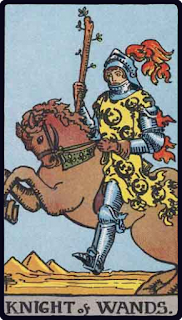
Representing discipline; the Knight of Wands represents the application of knowledge, and the combination of knowledge and experience which together produce wisdom. The Knight of Wands emphasises iteration and evolution, and the effort to guide others who would seek to follow in their footsteps.
In the upright state the Knight of Wands represents the embodiment of wisdom and the utility of our creative output. Skill, development, and training, are the focus for the Knight of Wands and serve as our prompt not to abandon our creative achievements upon completion, but to continue to use them and find utility within them. If ever there was a card to represent the call to recycle past creations, it would be the Knight of Wands.
In the inverted state the Knight of Wands represents the shortcomings of what we have created, the awareness of limitation in application. Whilst the creative process is objectively complete, the evolution of the creative output is not. What we have created can serve as the foundation of future creative endeavours that serve to iterate over our designs.
In the Rider-Waite deck the Knight of Wands rides on a horse wearing a yellow robe adorned with reptilian creatures; the symbolism of these creatures reflects the Reptilian Brain which is said to be driven by repetition and ritual, spurred on by instinct and impulse with emotional desires and their influence minimised. The reptiles depicted on their robes attempt to eat their own tails, an act which if achieved would create an Ouroboros, a symbol of reiteration and recursion, representing the evolution of the creative process.
Finally, three pyramids can be seen in the distance behind them representing the material essence or legacy of the creative process; our creative output will often persist and the utility therein may be found and adopted by generations to come.
In self-reflection the Knight of Wands serves as a prompt to consider the sources of wisdom and knowledge at your disposal and the example they set for you to follow. This is an opportunity to look to those who have already achieved what you seek and reflect on how they did it and identify the routine and mannerisms needed to do the same for yourself.
At this point you have gained your own experience, no longer the amateur, you stand aside those of achievement, treat them as equals and exchange your ideas. Recognise the strengths you have identified and the weaknesses you that have held you back or constrained your vision. Ask yourself “What do I need to work on?” and “What did they do differently?” when comparing your outcome to others, identify what you can learn from their experience to combine with your own.

No comments:
Post a Comment
All comments are moderated before they are published. If you want your comment to remain private please state that clearly.